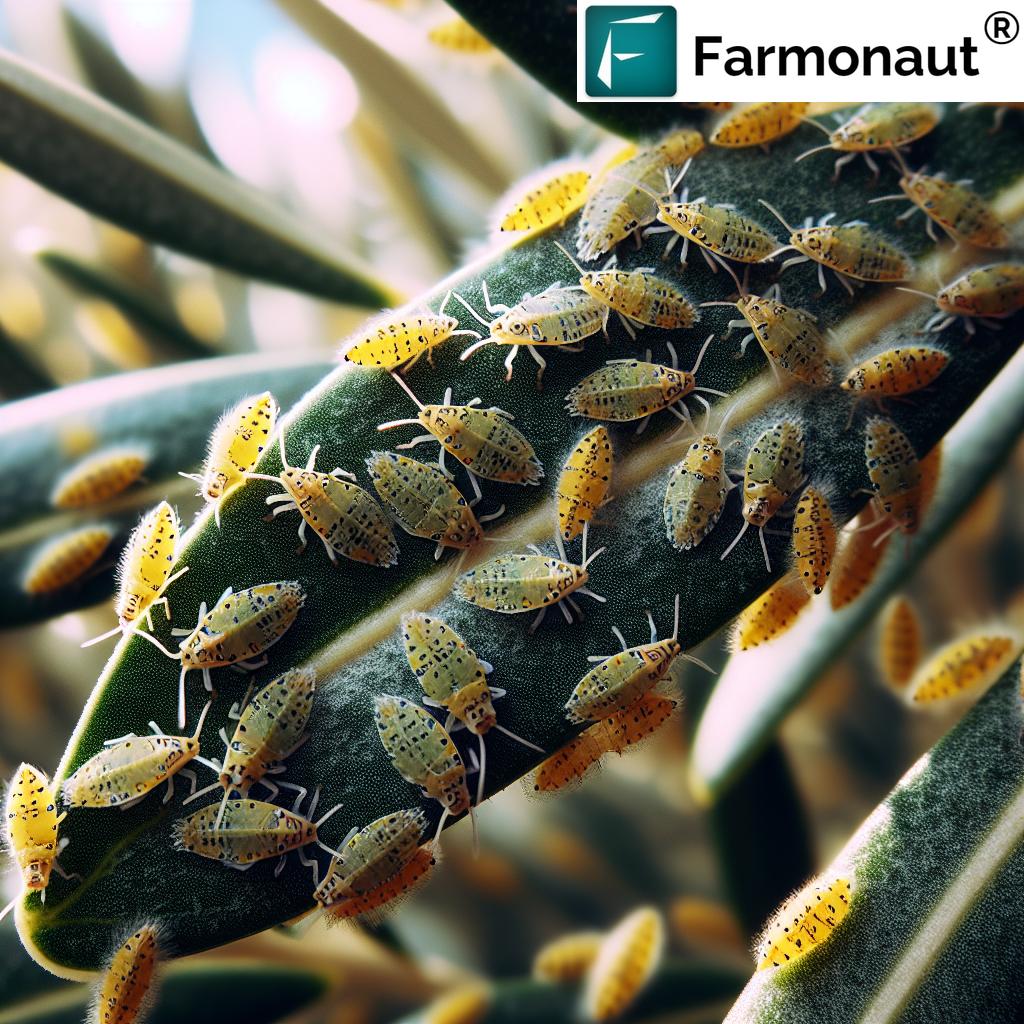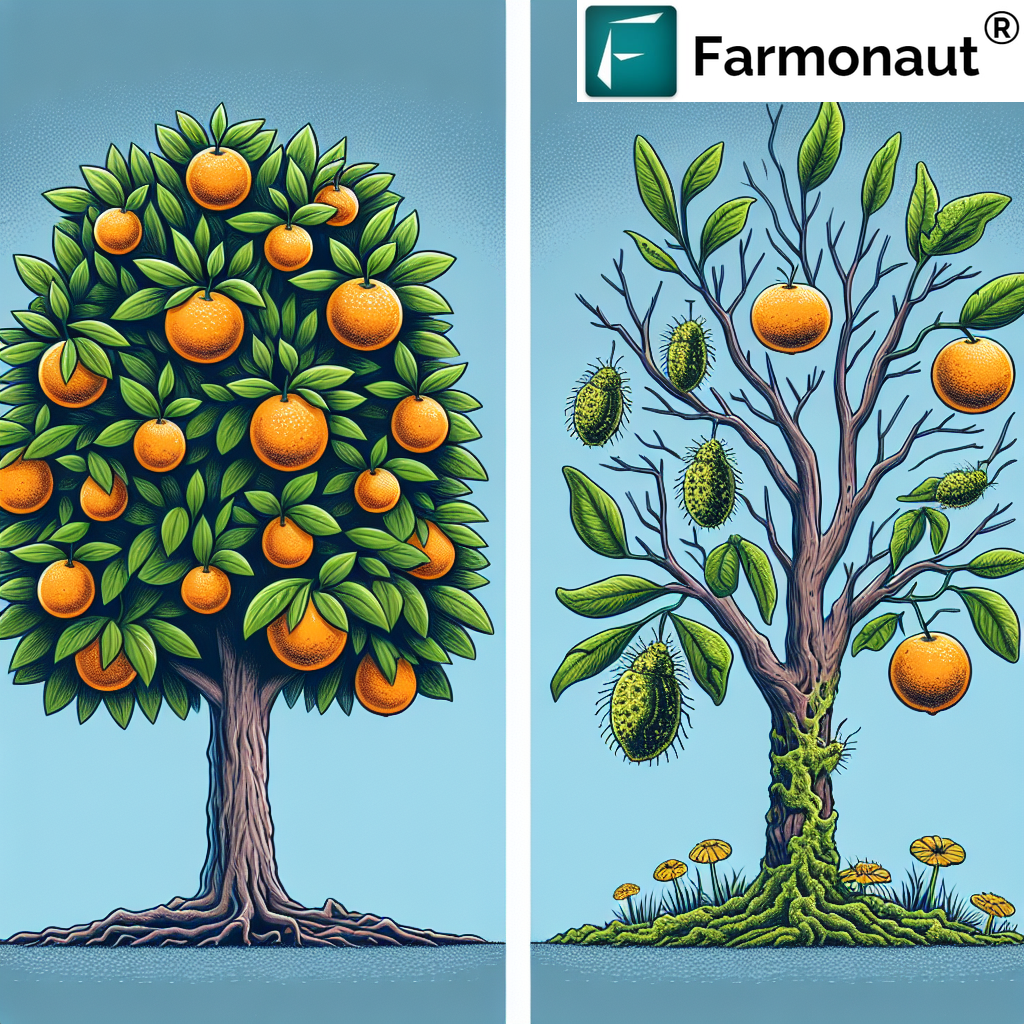Organic Olive Pest Control: Effective Treatments for Lace Bug and Other Leaf-Feeding Insects

Welcome to our comprehensive guide on organic olive pest control, focusing on effective treatments for the olive lace bug (OLB) and other leaf-feeding insects. As experts in agricultural technology and sustainable farming practices, we at Farmonaut understand the challenges faced by olive growers in maintaining healthy trees while adhering to organic principles. In this blog post, we’ll explore various organic products and methods to control infestations, ensuring your olive grove remains productive and environmentally friendly.
Understanding the Olive Lace Bug and Its Impact
The olive lace bug (Froggattia olivinia) is a significant pest that affects olive groves worldwide. These tiny insects feed on the undersides of olive leaves, causing damage that can lead to reduced yields and tree health. Let’s delve into the characteristics and behavior of this persistent pest:
- Appearance: Adult OLBs are small (about 2-3mm long) with lace-like wings, hence their name.
- Life Cycle: They undergo incomplete metamorphosis, with eggs, nymphs, and adults all present on the host plant.
- Feeding Habits: Both adults and nymphs feed on the undersides of leaves, sucking sap and causing chlorotic spots.
- Damage: Severe infestations can lead to leaf drop, reduced photosynthesis, and ultimately, decreased fruit production.
The Importance of Early Detection
Early detection of olive lace bug infestations is crucial for effective control. Traditional methods of pest detection often rely on manual inspection, which can be time-consuming and may miss early signs of infestation. At Farmonaut, we leverage advanced satellite technology to provide early and accurate pest detection capabilities. Here’s a comparison of traditional methods versus our satellite-based approach:
| Feature | Traditional Pest Detection | Farmonaut Satellite System |
|---|---|---|
| Early Detection | Relies on visual inspection, may miss early signs | Detects stress patterns before visible symptoms appear |
| Coverage Area | Limited to areas physically inspected | Covers entire groves with high-resolution imagery |
| Labor Requirements | High – requires regular manual inspections | Low – automated analysis of satellite data |
| Cost-effectiveness | Time-consuming and potentially costly for large areas | Highly cost-effective, especially for large-scale operations |
By utilizing our satellite-based pest monitoring system, olive growers can detect infestations earlier, cover larger areas more efficiently, and reduce labor costs associated with pest management. To learn more about our satellite monitoring capabilities, visit Farmonaut’s App.
Organic Treatment Options for Olive Lace Bug
When it comes to organic pest control in olive groves, there are several effective options available. These methods focus on maintaining the ecological balance while targeting the olive lace bug and other leaf-feeding insects. Let’s explore some of the most effective organic treatments:
1. Neem Oil
Neem oil is a powerful natural insecticide derived from the neem tree. It’s particularly effective against soft-bodied insects like the olive lace bug.
- Application: Mix neem oil with water and a small amount of mild soap as an emulsifier. Spray thoroughly on the undersides of leaves.
- Frequency: Apply every 7-14 days, or as needed based on infestation levels.
- Benefits: Neem oil not only kills insects on contact but also acts as a repellent and interferes with their feeding and reproduction.
2. Kaolin Clay
Kaolin clay creates a protective barrier on leaves and fruits, deterring pests from feeding and laying eggs.
- Application: Mix kaolin clay with water to form a slurry and spray it onto the trees. It dries to form a white, powdery film.
- Frequency: Reapply after rain or as the coating wears off.
- Benefits: Besides pest control, kaolin clay can also help reduce heat stress and sunburn on fruits.
3. Beneficial Insects
Introducing natural predators can help keep olive lace bug populations in check. Some effective beneficial insects include:
- Lacewings
- Ladybugs
- Predatory mites
These beneficial insects can be purchased from garden supply stores or online retailers specializing in biological pest control.
4. Horticultural Oils
Horticultural oils, such as mineral oil or vegetable-based oils, can be effective against olive lace bugs and other soft-bodied insects.
- Application: Dilute the oil according to manufacturer instructions and spray thoroughly, ensuring coverage of the undersides of leaves.
- Frequency: Apply every 7-14 days during active infestations.
- Caution: Avoid applying oils during hot weather or drought conditions, as this can stress the trees.
5. Pruning and Sanitation
Proper pruning and sanitation practices can significantly reduce olive lace bug populations:
- Remove and destroy infested leaves and branches.
- Maintain an open canopy to improve air circulation and reduce humidity.
- Clean up fallen leaves and debris around the base of the trees to eliminate overwintering sites for pests.
Implementing an Integrated Pest Management (IPM) Approach
At Farmonaut, we advocate for an Integrated Pest Management (IPM) approach to olive lace bug control. This strategy combines various methods to achieve long-term, sustainable pest management. Here’s how to implement an effective IPM program in your olive grove:
1. Monitoring and Early Detection
Regular monitoring is crucial for early detection of olive lace bug infestations. Our satellite-based monitoring system can help you detect stress patterns in your olive trees before visible symptoms appear. By subscribing to our service, you can receive alerts and detailed reports on the health of your olive grove.
Learn more about our satellite monitoring service
2. Cultural Practices
Implement cultural practices that promote tree health and create an environment less favorable to pests:
- Proper irrigation to avoid water stress
- Balanced fertilization to maintain tree vigor
- Regular pruning to improve air circulation
- Removal of weeds that may harbor pests
3. Biological Control
Encourage and introduce natural predators of the olive lace bug. This can be done by:
- Planting flowering plants that attract beneficial insects
- Releasing purchased beneficial insects strategically throughout the grove
- Minimizing the use of broad-spectrum pesticides that may harm beneficial insects
4. Organic Pesticides
When necessary, use organic pesticides as part of your IPM strategy. Remember to:
- Rotate between different organic pesticides to prevent resistance
- Apply pesticides during the most vulnerable stage of the pest’s life cycle
- Follow all label instructions and safety precautions
5. Record Keeping and Analysis
Maintain detailed records of pest populations, treatments applied, and their effectiveness. This information can help you refine your IPM strategy over time. Our Farmonaut app provides tools for easy record-keeping and analysis of your pest management efforts.
Download our Android app or get it on iOS to start tracking your olive grove’s health today.
The Role of Technology in Organic Olive Pest Management
At Farmonaut, we believe that technology plays a crucial role in modernizing and improving organic pest management practices. Our satellite-based monitoring system offers several advantages for olive growers:
1. Early Detection of Stress Patterns
Our advanced algorithms analyze multispectral satellite imagery to detect stress patterns in olive trees before they become visible to the naked eye. This early warning system allows growers to take preventive action against pest infestations.
2. Precision Application of Organic Treatments
By providing detailed maps of stressed areas within your olive grove, our technology enables precision application of organic treatments. This targeted approach not only improves the effectiveness of pest control but also reduces the overall use of organic pesticides, leading to cost savings and minimized environmental impact.
3. Data-Driven Decision Making
Our platform collects and analyzes data on pest populations, treatment effectiveness, and environmental conditions. This wealth of information empowers growers to make data-driven decisions about their pest management strategies.
4. Integration with Weather Data
Our system integrates real-time weather data, helping growers time their organic pest control applications for maximum effectiveness. For instance, avoiding application before expected rainfall or during periods of high wind.
To access our weather API and integrate it into your own systems, visit our API documentation page.
Case Study: Successful Organic Olive Lace Bug Control
To illustrate the effectiveness of organic pest control methods combined with our technology, let’s look at a hypothetical case study of an olive grove in California:
Scenario: A 50-acre organic olive grove was experiencing recurrent olive lace bug infestations, leading to reduced yields and tree health.
Implementation:
- The grower subscribed to Farmonaut’s satellite monitoring service.
- Early stress patterns were detected in a section of the grove.
- A targeted IPM strategy was implemented, including:
- Precision application of neem oil and kaolin clay
- Introduction of beneficial insects in affected areas
- Adjusted pruning practices to improve air circulation
- Continuous monitoring and data analysis guided ongoing management decisions.
Results:
- 80% reduction in olive lace bug population within one growing season
- 15% increase in overall yield compared to the previous year
- 30% reduction in organic pesticide usage due to targeted application
- Improved overall tree health and resilience
This case study demonstrates how combining organic pest control methods with advanced monitoring technology can lead to significant improvements in pest management and overall grove health.
The Future of Organic Olive Pest Control
As we look to the future, we at Farmonaut are excited about the continued integration of technology in organic olive pest management. Some emerging trends and technologies we’re exploring include:
1. AI-Powered Pest Identification
We’re developing machine learning algorithms that can identify specific pests, including the olive lace bug, from high-resolution satellite and drone imagery. This will allow for even more precise and timely interventions.
2. IoT Sensors for Microclimate Monitoring
Internet of Things (IoT) sensors deployed throughout olive groves can provide real-time data on temperature, humidity, and other factors that influence pest populations. This data, when combined with our satellite imagery, will offer unprecedented insights into pest behavior and optimal treatment timing.
3. Biological Control Enhancements
Research into new beneficial insects and microorganisms that prey on olive pests is ongoing. We’re staying at the forefront of these developments to incorporate the latest biological control options into our recommended IPM strategies.
4. Advanced Formulations of Organic Pesticides
Scientists are continually working on improving the efficacy and persistence of organic pesticides. We’re closely monitoring these advancements to ensure our customers have access to the most effective organic treatment options available.
Conclusion: Embracing Organic Solutions for Healthy Olive Groves
Organic olive pest control, particularly for managing the olive lace bug and other leaf-feeding insects, is a complex but rewarding endeavor. By combining time-tested organic methods with cutting-edge technology, olive growers can achieve effective pest management while maintaining the health of their trees and the surrounding ecosystem.
At Farmonaut, we’re committed to supporting organic olive growers with innovative solutions that make precision agriculture accessible and affordable. Our satellite-based monitoring system, coupled with our expertise in agricultural technology, provides a powerful tool for early detection, precise treatment, and data-driven decision-making in olive pest management.
We invite you to explore how our technology can transform your approach to organic olive pest control. Visit our website or contact our team to learn more about how we can help you achieve healthier, more productive olive groves through sustainable pest management practices.
Ready to take your organic olive pest management to the next level? Subscribe to our services today and join the future of sustainable agriculture.
Frequently Asked Questions (FAQ)
Q1: What are the signs of an olive lace bug infestation?
A1: Signs of olive lace bug infestation include:
- Yellowing or bleaching of leaves, particularly on the upper surface
- Small, dark spots on the undersides of leaves (insect excrement)
- Presence of small, lace-winged insects on the undersides of leaves
- Premature leaf drop in severe cases
Q2: How often should I apply organic treatments for olive lace bug control?
A2: The frequency of application depends on the specific treatment and the severity of the infestation. Generally:
- Neem oil and horticultural oils: Every 7-14 days during active infestations
- Kaolin clay: Reapply after rain or as the coating wears off
- Beneficial insects: Release according to supplier recommendations, typically once or twice per season
Q3: Can I use multiple organic treatments simultaneously?
A3: Yes, using multiple organic treatments as part of an Integrated Pest Management (IPM) approach can be very effective. However, it’s important to ensure compatibility between different treatments and avoid overuse, which could stress the trees or harm beneficial insects.
Q4: How does Farmonaut’s satellite monitoring detect olive lace bug infestations?
A4: Our satellite monitoring system uses multispectral imagery to detect stress patterns in olive trees. While it doesn’t directly visualize the insects, it can identify early signs of plant stress caused by infestations before they become visible to the naked eye. This allows for prompt intervention and more effective pest control.
Q5: Are organic treatments as effective as conventional insecticides for olive lace bug control?
A5: When used as part of a comprehensive IPM strategy, organic treatments can be highly effective for olive lace bug control. While they may work more slowly than conventional insecticides, organic treatments offer the benefits of being environmentally friendly, safe for beneficial insects, and less likely to lead to pest resistance over time.
Q6: How can I encourage natural predators of the olive lace bug in my grove?
A6: To encourage natural predators:
- Plant diverse flowering plants near your olive grove to attract beneficial insects
- Avoid broad-spectrum pesticides that can harm beneficial insects
- Provide water sources and shelter for beneficial insects
- Consider releasing commercially available predatory insects like lacewings or ladybugs
Q7: Can pruning help control olive lace bug infestations?
A7: Yes, proper pruning can help control olive lace bug infestations by:
- Improving air circulation within the canopy, creating a less favorable environment for pests
- Allowing better penetration of organic sprays when treatments are necessary
- Facilitating the removal of heavily infested branches or leaves
Q8: How does weather affect olive lace bug populations and treatment effectiveness?
A8: Weather can significantly impact olive lace bug populations and treatment effectiveness:
- Hot, dry conditions generally favor olive lace bug population growth
- Heavy rains can wash off some organic treatments, necessitating reapplication
- Wind can affect the efficacy of spray applications
Our weather API integration helps growers time their treatments for optimal effectiveness based on current and forecasted weather conditions.
Q9: Is it possible to completely eradicate olive lace bugs from my grove?
A9: Complete eradication of olive lace bugs is challenging and often not necessary or desirable. The goal of organic pest management is to keep pest populations below economically damaging levels while maintaining a balanced ecosystem. Consistent monitoring and timely interventions can effectively manage olive lace bug populations without aiming for complete eradication.
Q10: How can I get started with Farmonaut’s satellite monitoring for my olive grove?
A10: Getting started with Farmonaut’s satellite monitoring is easy:
- Visit our website and sign up for an account
- Define your olive grove boundaries using our user-friendly mapping tool
- Choose your preferred monitoring frequency and subscription plan
- Download our mobile app to receive real-time alerts and access detailed reports
Our team is available to provide support and guidance throughout the setup process and beyond.














